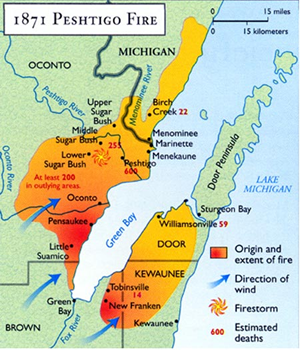The Peshtigo Fire
By Kim Estep, Green Bay Press-Gazette
Reprinted with permission from the Press-Gazette 
On October 8, 1871, the most devastating forest fire in American history swept through northeast Wisconsin, claiming 1200+ lives.
[For more about the Peshtigo fire, click here.]
The anniversary of the Peshtigo Fire usually receives little note outside the region because another horrific fire the same night -- the great Chicago Fire -- still seems to hog the headlines.
"Part of it is that myth of the cow -- Mrs. O'Leary's cow tipping over the lantern," said Debra Anderson, an archivist for the University of Wisconsin-Green Bay Area Research Center, referring to the way the Chicago fire allegedly started. "And, Chicago was and still is a bigger city."
While Chicago's story may be more colorful, researchers still find the Peshtigo Fire worth studying, Anderson said.
The Area Research Center, the state historical society's depository for records for 11 counties in Northeast Wisconsin, has papers and manuscripts of all kinds, she said.
The story of the Peshtigo Fire, gleaned from survivor accounts and conjecture, is that railroad workers clearing land for tracks that Sunday evening started a brush fire which, somehow, became an inferno.
It had been an unusually dry summer, and the fire moved fast. Some survivors said it moved so fast it was "like a tornado."
The sudden, convulsive speed of the flames consumed available oxygen. Some trying to flee burst into flames.
It scorched 1.2 to 1.5 million acres, although it skipped over the waters of Green Bay to burn parts of Door and Kewaunee counties. The damage estimate was at $169 million, about the same as for the Chicago Fire.
The fire also burned 16 other towns, but the damage in Peshtigo was the worst. The city was gone in an hour. In Peshtigo alone, 800 lives were lost.
"What most researchers find so fascinating is the effect it (the Peshtigo Fire) had on people's lives. It was so horrific," Anderson said. "Some people thought it was the end of the world."
The fire produced countless stories of heroics and tragedy, which are collected at the research center, as well as the Peshtigo Fire Museum in downtown Peshtigo.
There's the story of a man carrying a woman to safety he thought was his wife. When he found out it wasn't her, he went crazy. People said the Peshtigo River was the only haven from the fire, and one 13 year-old German immigrant girl said she held onto the horn of a cow all night in the river to survive.
The Peshtigo Fire Museum, located in a former church building, is located at the corner of Oconto Street and Ellis Avenue in Peshtigo.